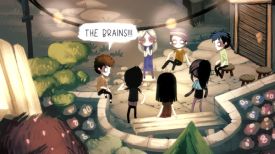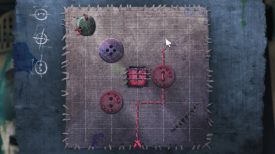|
By flotsam
Children of Silentown
Elf Games/Daedelic Entertainment
If
darkish animation adventures are your thing, then head on over to
Silentown. Location, a dark monster filled forest. Population, not as
many as there once were.
Children of Silentown tells the story of Lucy, a girl growing up in a
town surrounded by a monster-filled forest, and from which people
regularly disappear. The roars from the forest fill Lucy's dreams as
well as her drawings, but she is determined to get to the bottom of
whatever is haunting the town.
But not just yet. First there are chores to do, and fun to be had, and
clues to be gathered, all within the town.
The town isnít a big place, and you will likely go back and forth in the
normal course of completing your current task. Being required to do so
multiple times for different purposes could be considered a tad tedious,
but I thought both the particular circumstances for doing so and the
information garnered for the bigger storyline kept the compulsory
revisits to the different town locations reasonably Ďfresh.í True it is
that e.g., finding people to talk to about the monsters, and looking for
your friends as part of a game of hide-and-seek, plays out in the same
environment, but the Ďvibeí of your endeavours prevents it feeling stale
or forced. And while the environment might be the same, the goings on
are not.
Plus, the game knows when enough is enough. The makers have a good sense
of balance, evident in other aspects of the game. Right about the time I
was thinking ďwe need to get to the forest soon,Ē we got to the forest.
And while Lucy went back to the town, it wasnít the same as when she
left.
It
is all point and click, hot spots generating a single icon (look, talk
or take) and which might lead to the generation of a different one
(looking at something for instance might mean you can then take it). A
little set of gears will accompany the capacity to deploy an inventory
item. You can't reveal hot spots so explore carefully. Scenes will slide
in various directions as you walk around and arrows will indicate exits.
The 2D animation style is particularly appealing; it has a Tim Burton
tinge I liked a lot, and it suits (and adds to) the overall feel.
The intricacies of the story you can discover for yourself, but suffice
to say I enjoyed playing Lucy. She was determined to understand, and was
not going to be deterred. The weirdness of the events outside the town
was just another task to be completed. She wasnít foolhardy, but nor was
she cowed. Monsters be damned.
Ambient sound and a musical score provide the auditory palette, there
being no spoken word apart from a short voice over at the start and at
the end. Talking to people generates little speech bubbles that you
click to advance once you are ready.
Through the course of the game you can be awarded stickers for doing
certain things, which to my knowledge serve no purpose other than to be
collected and then viewed in your journal which is where you can also
view the musical notes that you Ďfind.í Unlike the stickers, these are
fundamental to making progress. Find sufficient notes and you will be
able to sing a little four note melody, which when successfully deployed
will trigger a self-contained puzzle.
There were three different puzzles, each unique to one of the tunes.
When a tune is required, only one of them will work. I mention that only
to be clear that you canít choose which puzzle to generate by choosing
which tune to use. You will get a sense of which tune works where (one
on people for instance, another on places) and in what circumstances (is
the person reluctant to share their thoughts perhaps). If the tune can
be utilised, Lucy will give it a melodious trill and the relevant puzzle
will pop-up.
You can back out of the puzzle, but solve it you must. One involves
gears and rotating tiles, another a thread and buttons (and later on
portals), the last a series of eyes generating light across a grid. Each
had their own peccadilloes and rules, each getting harder as you
progress in the game. That doesnít do them justice, and puzzle wise they
do much of the heavy lifting.
They did give me pause to Ö well, pause. Only one is remotely connected
to the game, and if you canít solve them you are stuck. You can say that
about any puzzle, but you might be tempted to be less generous towards
these given their largely Ďstuck oní nature. They canít be skipped, and
if you canít do them (random clicking will likely only get you so far),
you canít move on.
Having said that, there is a logicalness to each of them that worked for
me, one that I like a whole lot better than e.g., a convoluted inventory
solve that you couldnít possibly fathom. Sure you can try everything
with everything in the latter, but give me logical over fanciful any
day. Further, everything you need is right there, and even the one that
I groaned about each time I had to do it (and then gritted my teeth and
determinedly solved) could be broken down and nutted out.
Which isnít to say I wasnít frustrated by my inability to nut at times;
they can be difficult, the gear one more than the others in my opinion.
By
contrast, the inventory puzzle solving is less problematic, unless of
course you havenít found the item you need or canít quite fathom how you
might deploy it. Only once or twice did I resort to trying things just
out of hope. Usually I had a good idea of what to do and how I might go
about doing it. Which didnít always work, but then after a bit of
pondering something else generally came to mind. I did need two prods
along the way, one the result of my own impatience and the other a Ďduhí
moment when I realised what I hadnít done.
I
mentioned balance before. There was a segment towards the end where I
began to think the game was leaning a bit too heavily on the pop-up
puzzles. I would do one, move on a little and then have to do another.
But just before I got a little antsy, the game served up a rather large
multi-faceted environmental puzzle that soothed any beast that might
have been tempted to stir. Whilst it might just have been me, I rather
think the makers appreciated how far to go before you need to go
somewhere else, or offer a point of difference. Well done, them.
The Steam page talks about playing mini-games against the other
children. The pop-up puzzles I referred to arenít played against anyone
apart from yourself, but there was one occasion on which I had to win
twice while racing different animals against other children. If there
are other such games, I missed them and they therefore arenít
obligatory.
The mechanics of the game will be familiar to most, but the game itself
does an excellent job of providing feedback on what to do. The tunes,
the pop-up puzzles, even the first time I had two inventory items that
could be combined, all came with a little tutorial about what and how to
do it. It should ensure that the considerable enjoyment experienced thus
far is accessible to all.
Your inventory is a little pouch top left, and just click an item to try
and use it in the game world. Right click it on another item to try and
combine. The journal is top right, and the tunes available to you are
bottom right, each with their own icon. Use them like an inventory item.
There are no manual saves in Silentown, but the game autosaves
incessantly so that shouldn't be an issue. It does mean though that you
canít reset the world to what it was before, which I quite like, but
which could impact e.g., how you go about the large environmental puzzle
near the end. As well, the tunes operate a little differently in the
forest, and then completely differently towards the end of the game, and
you also have to pick one to sing right at the very end of the game - so
make sure to remember which icon is which. I assume the endings are
different depending which one you pick, but as you canít load an earlier
save I couldnít go back and see. Which is about the only thing that I
would change.
It
ended a little suddenly, but I thought rather satisfyingly based on the
ending I got. It clocked in at just over 10 hours and I thoroughly
enjoyed all of them.
I played on:
OS: Windows
10, 64 Bit
Processor:
Intel i7-9700K 3.7GHz
RAM: Corsair
Dominator Platinum RGB DDR4 32GB
Video card:
AMD Radeon RX 580 8192MB
GameBoomers Review Guidelines
January 2023
design copyright© 2023
GameBoomers
Group
 GB
Reviews Index GB
Reviews Index |






